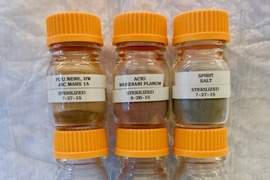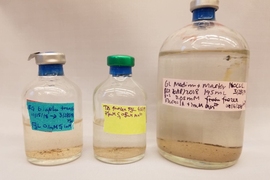Planetary scientists believe that Mars was once warmer, had a significant atmosphere, and maintained abundant flowing water that carved out river channels and pooled in lakes. These conditions would, at least theoretically, support life. But following a July 2020 launch, a 34 million mile journey, and an elaborately choreographed descent though the scant Martian atmosphere, NASA’s Mars 2020 rover will encounter an entirely different world. Freezing. Dry. And with an atmosphere so thin that even if the temperature warmed enough to melt the polar ice caps, the water would immediately evaporate.
What happened to Mars? And did life ever exist on our dusty, red neighbor?
To investigate this Martian mystery, the Mars 2020 rover will collect cores of sediments and rocks that will be sealed in tubes and eventually brought to Earth. Once they’ve arrived, the cores can be analyzed with the same instruments and techniques researchers use to understand the deep history of Earth. However, the samples must be chosen strategically because only about three dozen can be brought back — not very many for researchers attempting to characterize the biological and geological history of an entire planet.
Associate professor of geobiology Tanja Bosak and professor of planetary sciences Ben Weiss, both in the MIT Department of Earth, Atmospheric and Planetary Sciences (EAPS), have been selected as participating scientists on the mission. They will be among the group of 10 people who will decide which samples to collect. Bosak has also been selected for an additional leadership position as a member of the Project Science Group, which outlines mission strategies and coordinates the different groups of scientists involved with Mars 2020.
Looking for Martian fossils
Bosak, an expert in fossilization processes, says that looking for signs of ancient life on Mars is especially challenging, because “if there was any life, it would have been microbial. [What] we need to do is to look for something microscopic.” Fossil relics of any kind are rare compared to the original population, and soft-bodied, microbial fossils are even more exceptional. Given this, “we need to look for life in environments where that life would have been abundant and likely to be preserved,” she says.
Planetary scientists suspect past life would have been abundant near water, which informed their choice to send the rover to Jezero crater, believed to be the site of an ancient lake. Satellite images suggest that the lake was fed by a river, which deposited sediments in a delta at its mouth. Cameras and portable analytical instruments on the rover will help the researchers acquire compositional data about these sediments before they decide to take a precious core sample. Bosak plans to use these tools to search for deposits of carbonate, clay minerals, and amorphous silica. These substrates or their analogs are known to preserve microbial structures or fossils on Earth.
Once the researchers have located interesting sediments, they can use the rover’s drill to dig in a bit, and a camera to look inside. On Earth, microbial fossilization processes can create visible formations in sediments that can’t be duplicated by abiotic geological processes. If the rover peers into a drill hole and sees this type of formation, it would be very compelling evidence of past life on Mars. However, researchers may have to wait until the samples can be scrutinized with more sophisticated technology back on Earth to see if they’ve found signs of life or chemical precursors of life.
Martian magnetism
If there is a story of life on Mars, there may also be a story of death — the catastrophic loss of an atmosphere, and potentially with it, a temperate environment and liquid water.
“The big question is, why did Mars go from being warm and wet to cold and dry,” says Weiss, a planetary geophysicist. “One of the leading ideas is that it lost its atmosphere.” If Mars lost a once-stable atmosphere, there would no longer be a greenhouse effect to keep the planet warm, or the atmospheric pressure necessary to keep liquid water from boiling. But what could have happened to the atmosphere?
“The hypothesis is that Mars lost its magnetic field and then the atmosphere was stripped away,” says Weiss. Planetary magnetic fields are generated by the churning of molten metals in the planet’s core. The field repels and redirects charged radiation from the sun that would otherwise destructively react with molecules in the atmosphere. If the Martian atmosphere was destroyed by unmediated solar radiation after losing its magnetic field, evidence of this event may be found inside Martian rocks.
When a rock is forming on a planet with a magnetic field, the electrons in the atoms that make up the rock will align themselves to the magnetic field. The stronger the planet’s magnetism, the more electrons in the rock will align themselves to it. Without a magnetic field, electrons orient randomly.
By acquiring a series of rock samples ranging in age from the very old to very young, and determining the proportion of aligned electrons in each sample, researchers could potentially track the disappearance of the Martian magnetic field. Weiss says that this timeline could then be compared to the record of climate change on Mars to see if loss of the magnetic field did, in fact, precede cooling and loss of water.
Scientific consensus
While Bosak and Weiss approach the Martian mystery from different angles, they and the other participating scientists will strive to ensure that each sample they collect will be useful to scientists across disciplines. “These 30 or so samples basically have to be shared [by] all of humanity. So, our job is not to just represent our own particular interests, but to represent the entire community today and conceive of what future generations might want,” says Weiss. “It's going to be a big, long debate every time we take any sample.”
Finding evidence of past life on Mars would be a remarkable discovery, but Bosak points out that there would still be a lot to learn about life even if Mars is completely sterile. “Mars is very similar to us in the sense that it did have liquid water. If we see that everything [on Mars] is sterile, that really does invite a whole bunch of questions about why it’s sterile,” she says. “What was not quite right for life? Or, if you find some evidence for prebiotic chemistry or something, [but not evidence of] cellular life, what made it stop?” Either way, “this is a really super exciting opportunity to get some answers.”
JPL built and will manage operations of the Mars 2020 rover for NASA’s Science Mission Directorate. NASA's Launch Services Program, based at the agency's Kennedy Space Center in Florida, is responsible for launch management.











